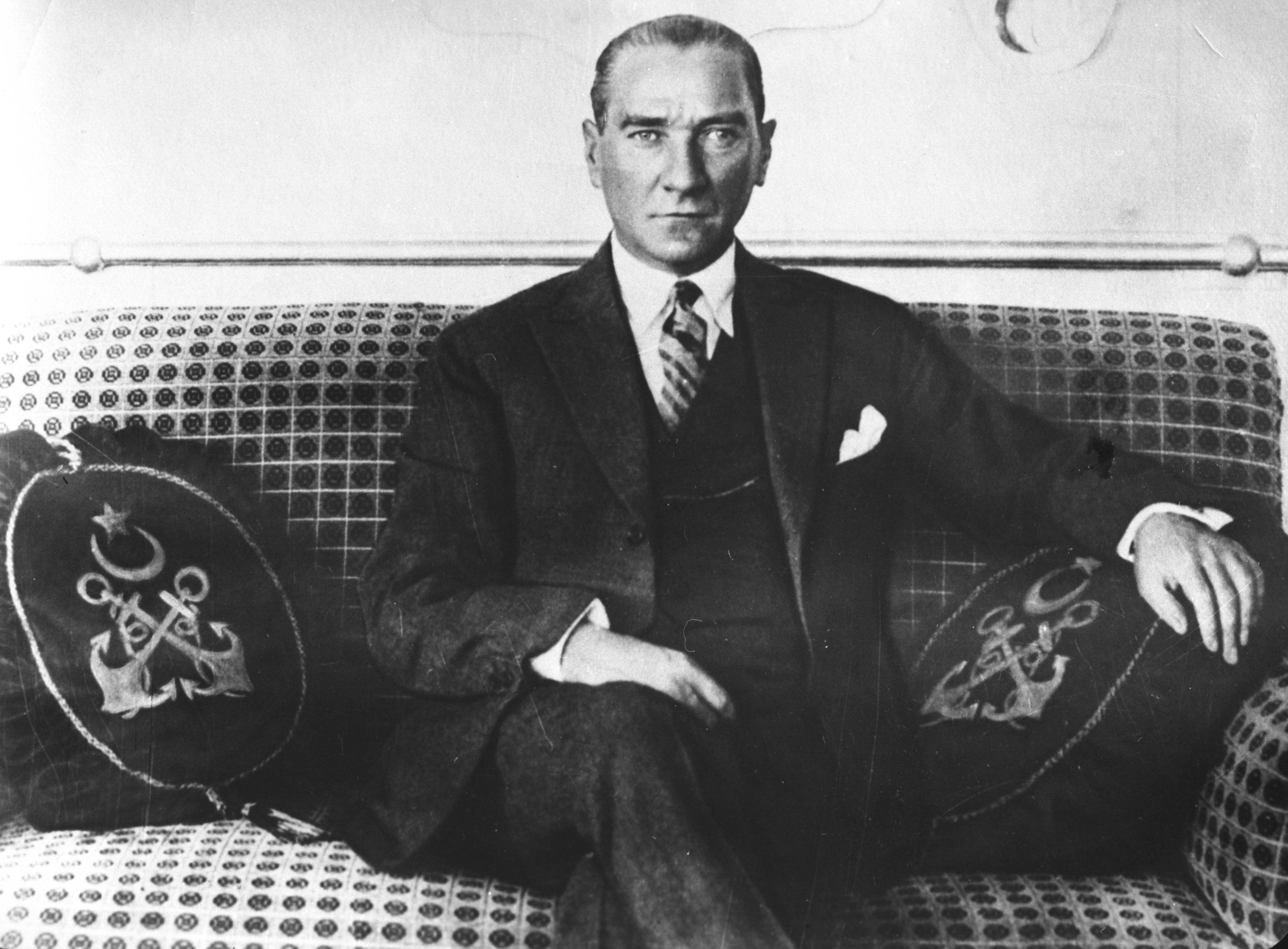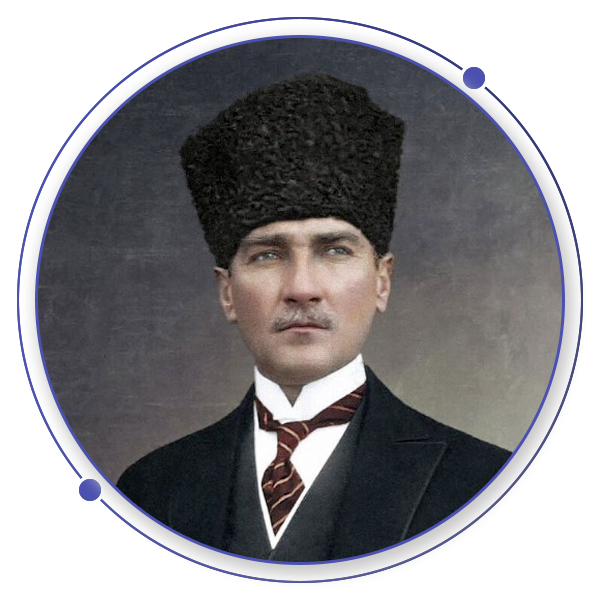Mustafa Kemal Atatürk
Mustafa Kemal Atatürk
 Turkey
Turkey Ottoman Empire
Ottoman EmpireMustafa Kemal Atatürk, or Mustafa Kemal Pasha and Ghazi Mustafa Kemal (1881– 10 November 1938) was a Turkish field marshal, revolutionary statesman, author, and the founding father of the Republic of Turkey, serving as its first president from 1923 until his death in 1938. He undertook sweeping progressive reforms, which modernized Turkey into a secular, industrializing nation. Ideologically a secularist and nationalist, his policies and socio-political theories became known as Kemalism. Due to his military and political accomplishments, Atatürk is regarded as one of the most important political leaders of the 20th century.
For his primary education, he went to the school of Şemsi Efendi in Salonika. But Mustafa lost his father at an early age. He had to leave school. Mustafa and his mother went to live with his uncle in the country. His mother brought him up. Life continu ed like this for a time. Mustafa worked on the farm but his mother began to worry about his lack of schooling. It was finally decided that he should live with his mothers sister in Salonika.
He entered the Military Middle School in Salonika. In 1895, after finishing the Military Middle School, Mustafa Kemal entered the Military High School (Askeri İdadisi ) in Manastir (Manastır). After successfuly completing his studies at the Manastir Military School, Mustafa Kemal went to İstanbul and on the 13th of March 1899 he entered the infantry class of the Military Academy. (Harbiye Harp Okulu) After finishing the Military Academy, Mu stafa Kemal went on to the General Staff College in 1902. He graduated from the Academy with the rank of captain on the 11th of January, 1905.
Mustafa Kemal was assigned to the 5th Army in Damascus and the 3rd Army in Macedonia in in 1905 and 1907 respectively. While he was on duty in Monastir and Salonika, he served in the Operations Army, which suppressed the rebellion (31 March Incidents) in Istanbul Similarly, he also participated in the operation to fight against the rebellion in Albania.
In 1911, upon the occupation of Tripoli by Italy, he was sent to Tobruk. He successfully led the Turkish Forces in Tobruk and Darnah. He participated in the Balkan War with the rank of major in 1912 and1913 and served in the army corps which recaptured Edirne from Bulgaria.
In 1915, during the World War I, he fought in the Çanakkale (Dardanelles) Battle as the 19th Division Commander. He successfully stopped the enemy attacks at Gelibolu (Gallipoli), a victory which brought him fame as the “Hero of the Anafarta Heights.''
He was appointed as the Army Corps Commander to the Eastern Front in 1916 and rose to the rank of Brigadier General. He stopped the Russian attacks and recaptured Bingöl and Muş from the enemy. In 1917 he was appointed to the 7th Army Command that was in charge of Palestine and Syria. The same year he went to Germany with the Heir Prince Vahideddin.
He made observations at the German General Headquarters as well as the German battle fronts. As he was serving in the Syrian front as the 7th Army Commander in 1918, the World War I ended and he returned to Istanbul following the Armistice of Moudros. He departed from Istanbul as an army inspector although his secret objective was to end the occupation of the country by the Allied Forces.
After arriving in Samsun on 19 May 1919 via the Black Sea, Mustafa Kemal issued the Amasya Circular on 22 June 1919 in which he announced the Turkish Nation that “the integrity of the country and the independence of the nation are in danger and a congress will be convened in Sivas in order to save the country with determination and decisiveness.” Subsequently, he resigned from the duties that were assigned by the Ottoman government as well his military post. Mustafa Kemal chaired the conventions held in Erzurum and Sivas on 23 July 1919 and 4 September 1919 respectively.
The most important decisions made at these conventions stipulated that the nation would defend the country against the occupation and towards that aim a temporary government would be formed after a national parliament is convened and no mandate or protection would be accepted for that matter. Thanks to his efforts, the Turkish Grand National Assembly (TBMM) convened for the first time on 23 April 1920 in Ankara. Mustafa Kemal was elected as the head of the parliament and the government and his first job was to announce the world that the Turkish nation does not recognize the Sèvres Treaty, which was signed between the Ottoman Government and the Allied Forces.
The advancement of the Greek army which had occupied Izmir with the help of the Allied Forces was stopped in the First and Second Inönü battles in 1921 and the Greeks were vigorously repulsed. The Turkish Army, led by Commander-in-Chief Mustafa Kemal Paşa won a victory in the Battle of the Sakarya River. The Greek Army suffered severe losses in this battle which lasted for 22 nights and days. Mustafa Kemal was promoted to the rank of “Marshal” and given the title of “Gazi” (war veteran) by the TBMM due to this victory.
The Turkish Army started to counter-attack the Allied Forces on 26 August 1922 to end the enemy occupation completely. The Greek Army was largely defeated under the command of Mustafa Kemal in the Battle of the Commander-in-Chief (30 August 1922). The Turkish Army chased the defeated enemy forces and entered Izmir on 9 September 1922. Consequently, the Mudanya Armistice was signed on 11 October 1922 as a result of which the Allied Forces withdrew from the Turkish territories.
Following the Turkish War of Independence, not only the modern Turkish Republic was established, but also Mustafa Kemal was elected as the first President of the new Republic on 29 October 1923. Until he passed away in 1938, Mustafa Kemal Atatürk served as the President of Türkiye which makes him the only person to hold this distinguished post for the longest period. He was elected to the Presidency for four consecutive terms.
Mustafa Kemal was given the last name ‘Atatürk' on 24 November 1934 with the law numbered 2587 and the right to adopt the same last name was reserved for him only.
Atatürk was not only a commander-in-chief who led the War of Independence successfully, but also a genius statesman given the reforms that he realized. During most of his 57 year-long life, Atatürk tirelessly worked for the happiness of the nation and the independence of the country and he emerged victorious from every battle he fought.
The founder of the Republic of Türkiye and unforgettable and brave leader passed away in Istanbul on 10 November 1938.
Atatürk gave his Great Speech on 15-20 October 1927 in which he described the Independence War and Founding of Republic, he then made his 10th Year Speech on 29 October 1933.
Atatürk was very modest in his private life. He married with Latife Hanim on 29 January 1923. Together they had many trips around the country. Their marriage lasted until 5 August 1925. As a great lover of children, Atatürk adopted his daughters Afet (Inan), Sabiha (Gökcen), Fikriye, Ülkü, Nebile, Rukiye, Zehra and his son Mustafa, a young shepherd boy. He also had two children under his protection, Abdurrahim and Ihsan. He secured a good life and future for these children who survived.
In 1937, he donated his farms to the State Treasury and some of his real estate to Ankara and Bursa Municipality Councils. He divided his inheritance among his sister, his adopted children and the Turkish Language and Historical Societies. He enjoyed reading, listening music, dancing, horse riding and swimming. He was very much interested in the Western Anatolian folk dance Zeybek, wrestling and listening to Rumelia songs. He had great pleasure in playing black-gammon and billiards. He valued very much his horse Sakarya and his dog Fox. He had made up a very rich library of his own. He used to invite statesmen, scholars and scientists to dinners and discuss state affairs with them. He was very particular about his appearance and was smartly dressed all the times. He was also a nature lover. He very often used to visit his farm Atatürk Orman Ciftligi-Atatürk Forest Farm and took part at works in person. Atatürk was proficient in French and German.
On 10 November 1938 at 9.05 in the morning, in Istanbul, Dolmabahce Palace, he died of the liver ailment he was suffering from. He was buried with a ceremonial funeral in a temporary place of rest at the Ethnographical Museum in Ankara on 21 November 1938. After the building of Anitkabir (Atatürk Mausoleum) he was taken to his permanent place of rest with a grand ceremony on 10 November 1953.


